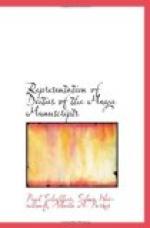In regard to the significance of this deity, he doubtless represents the personification of a heavenly body of astronomic importance, probably the polar star. In Codex Cort. 10 (bottom), his head is represented surrounded by a nimbus of rays, which can only mean a star (see Fig. 13). On the lower part of the same page, the third picture from the left, we again see the deity hanging from the sky in a kind of rope. Furthermore it appears in Codex Tro. 20, 22 and 23 (centre) Fig. 14, in the familiar rectangular planet signs. Tro. 17* (at the top) the head surmounts the cross-shaped tree of god B, which denotes the lofty, celestial abode. Indeed, these passages prove positively that a heavenly body underlies the idea of this deity.
Furthermore, the head of this god recurs in entire rows in the calendric group of tabular form on the so-called initial page of the Codex Tro. 36, with its continuation in the Cort. p. 22, and in exactly the same manner in the allied passage of Tro. 14 (middle and bottom). In addition, his head is contained in the symbol for the north (Fig. 16); the head contained in this sign is in fact nothing else than the head of god C.
Brinton also accepts this interpretation of god C. According to Foerstemann (Die Mayahieroglyphen, Globus, Vol. 71, No. 5), the fact that the figure of god C in the Tonalamatl in Dr. 4a-10a occurs on the day Chuen of the Maya calendar, which corresponds to the day Ozomatli, the ape, in the Aztec calendar, seems to indicate that the singular head of C is that of an ape, whose lateral nasal cavity (peculiar to the American ape or monkey) is occasionally represented plainly in the hieroglyph picture. Hence it might further be assumed that god C symbolizes not the polar star alone, but rather the entire constellation of the Little Bear. And, in fact, the figure of a long-tailed ape is quite appropriate to the constellation, at any rate decidedly more so than the Bear; indeed, it suggests the prehensile tail by means of which the ape could attach himself to the pole and in the form of the constellation swing around the pole as around a fixed point.




